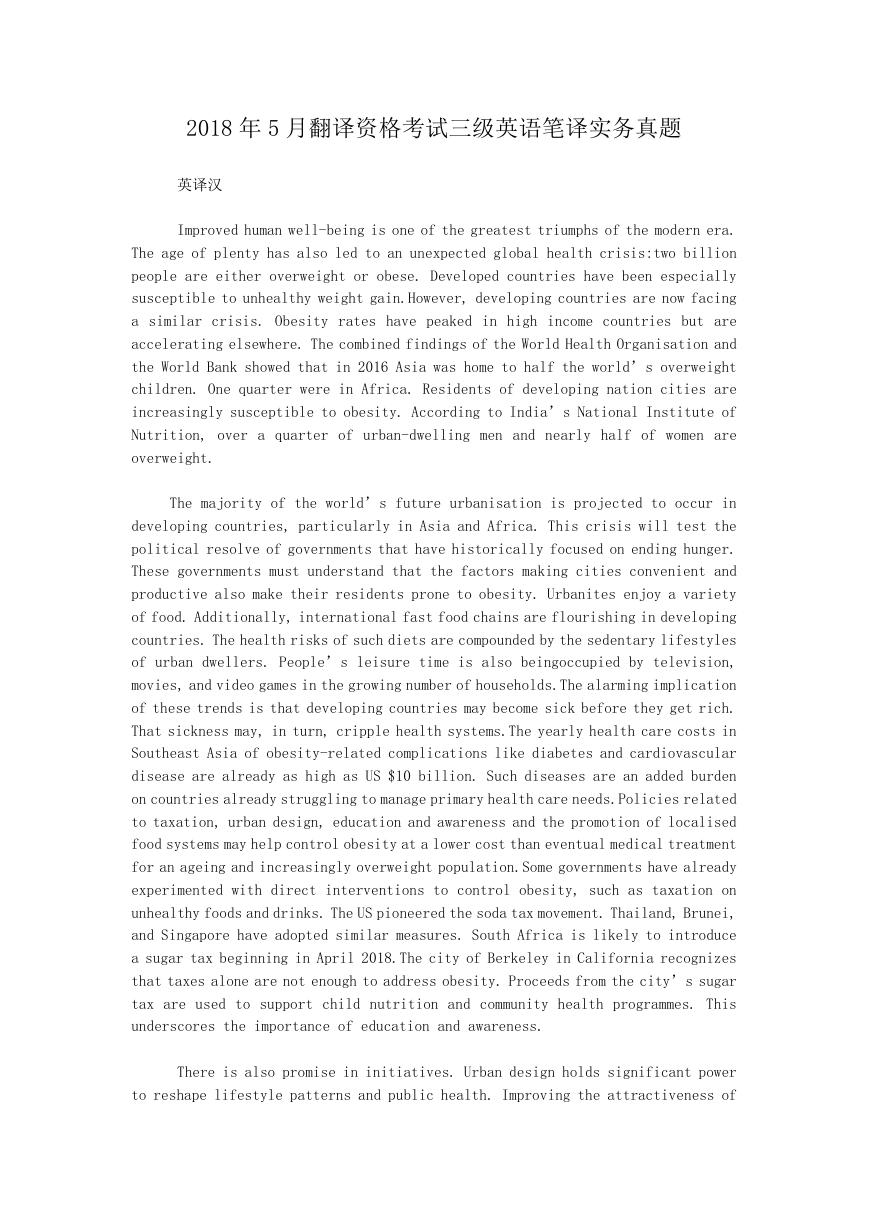2018 年 5 月翻译资格考试三级英语笔译实务真题
英译汉
Improved human well-being is one of the greatest triumphs of the modern era.
The age of plenty has also led to an unexpected global health crisis:two billion
people are either overweight or obese. Developed countries have been especially
susceptible to unhealthy weight gain.However, developing countries are now facing
a similar crisis. Obesity rates have peaked in high income countries but are
accelerating elsewhere. The combined findings of the World Health Organisation and
the World Bank showed that in 2016 Asia was home to half the world’s overweight
children. One quarter were in Africa. Residents of developing nation cities are
increasingly susceptible to obesity. According to India’s National Institute of
Nutrition, over a quarter of urban-dwelling men and nearly half of women are
overweight.
The majority of the world’s future urbanisation is projected to occur in
developing countries, particularly in Asia and Africa. This crisis will test the
political resolve of governments that have historically focused on ending hunger.
These governments must understand that the factors making cities convenient and
productive also make their residents prone to obesity. Urbanites enjoy a variety
of food. Additionally, international fast food chains are flourishing in developing
countries. The health risks of such diets are compounded by the sedentary lifestyles
of urban dwellers. People’s leisure time is also beingoccupied by television,
movies, and video games in the growing number of households.The alarming implication
of these trends is that developing countries may become sick before they get rich.
That sickness may, in turn, cripple health systems.The yearly health care costs in
Southeast Asia of obesity-related complications like diabetes and cardiovascular
disease are already as high as US $10 billion. Such diseases are an added burden
on countries already struggling to manage primary health care needs.Policies related
to taxation, urban design, education and awareness and the promotion of localised
food systems may help control obesity at a lower cost than eventual medical treatment
for an ageing and increasingly overweight population.Some governments have already
experimented with direct interventions to control obesity, such as taxation on
unhealthy foods and drinks. The US pioneered the soda tax movement. Thailand, Brunei,
and Singapore have adopted similar measures. South Africa is likely to introduce
a sugar tax beginning in April 2018.The city of Berkeley in California recognizes
that taxes alone are not enough to address obesity. Proceeds from the city’s sugar
tax are used to support child nutrition and community health programmes. This
underscores the importance of education and awareness.
There is also promise in initiatives. Urban design holds significant power
to reshape lifestyle patterns and public health. Improving the attractiveness of
�
public space can draw residents out of their cars and living rooms. A recent study
of urban neighbourhoods in Shanghai and Hangzhou found that middle-income residents
living in less walkable neighbourhoods had significantly higher Body Mass Indices
than both richer and poorer residents who lived in walkable neighbourhoods in urban
China.Finally, healthier lifestyles begin in grocery store aisles. Governments
should encourage tighter connections between agricultural production systems, urban
grocers and food vendors. Such initiatives can also help urban residents better
understand the mechanics of food sourcing. This raises awareness about the
relationship between natural foods and healthy lifestyles. Combining controls on
unhealthy foods with policies that incentivise healthy eating and active lifestyles
constitute a promising response to rising obesity rates. Improving public health
is an important policy developing countries should take from both an economic and
social point of view. To quote the recent Global Nutrition Report, reducing obesity
will boost global development.
汉译英
煤炭是地球上储量最为丰富的能源,但反对使用煤炭的声浪日益高涨。煤炭巨大的碳排
放量引起气候变化,从而引起公众的担忧。煤炭与其他能源相比,竞争力已经有所下降了。
以美国为例,页岩气的出现造成部分出煤量因价格过高而被挤出市场。美国去年煤炭需求接
近 9.2 亿吨。由于天然气价格下跌,今年美国煤炭需求将减少 6000 万到 8000 万吨。
数据显示,煤炭满足了全球大约 30%的能源需求,提供 40%以上的电力。在人口第一和
第二大国中国和印度,煤炭所满足的能源需求比例甚至达到 70%左右。中国的煤炭消费量在
去年已经下滑,煤炭进口下降了 11%,这是十年来的首次下降。中国经济增速已经放缓,同
时也做出极大努力削减煤炭使用以减少煤炭污染。由于燃煤发电厂没有满负荷运行,再加上
煤炭供应充足,造成国际煤炭价格压低。煤出口价格从去年的峰值下跌了约 60%。
�




 2023年江西萍乡中考道德与法治真题及答案.doc
2023年江西萍乡中考道德与法治真题及答案.doc 2012年重庆南川中考生物真题及答案.doc
2012年重庆南川中考生物真题及答案.doc 2013年江西师范大学地理学综合及文艺理论基础考研真题.doc
2013年江西师范大学地理学综合及文艺理论基础考研真题.doc 2020年四川甘孜小升初语文真题及答案I卷.doc
2020年四川甘孜小升初语文真题及答案I卷.doc 2020年注册岩土工程师专业基础考试真题及答案.doc
2020年注册岩土工程师专业基础考试真题及答案.doc 2023-2024学年福建省厦门市九年级上学期数学月考试题及答案.doc
2023-2024学年福建省厦门市九年级上学期数学月考试题及答案.doc 2021-2022学年辽宁省沈阳市大东区九年级上学期语文期末试题及答案.doc
2021-2022学年辽宁省沈阳市大东区九年级上学期语文期末试题及答案.doc 2022-2023学年北京东城区初三第一学期物理期末试卷及答案.doc
2022-2023学年北京东城区初三第一学期物理期末试卷及答案.doc 2018上半年江西教师资格初中地理学科知识与教学能力真题及答案.doc
2018上半年江西教师资格初中地理学科知识与教学能力真题及答案.doc 2012年河北国家公务员申论考试真题及答案-省级.doc
2012年河北国家公务员申论考试真题及答案-省级.doc 2020-2021学年江苏省扬州市江都区邵樊片九年级上学期数学第一次质量检测试题及答案.doc
2020-2021学年江苏省扬州市江都区邵樊片九年级上学期数学第一次质量检测试题及答案.doc 2022下半年黑龙江教师资格证中学综合素质真题及答案.doc
2022下半年黑龙江教师资格证中学综合素质真题及答案.doc